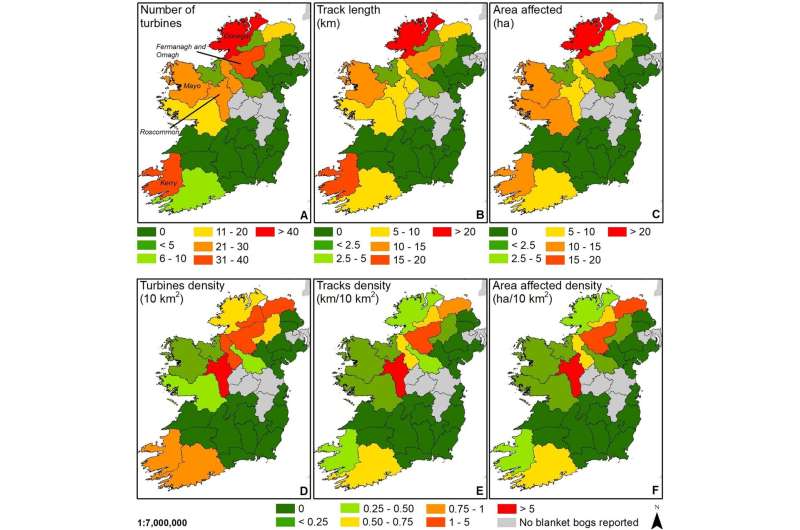This article has been reviewed according to Science X's editorial process and policies. Editors have highlighted the following attributes while ensuring the content's credibility:
fact-checked
peer-reviewed publication
trusted source
proofread
Researchers warn of 'urgent' need to understand impact of wind farms on precious peatlands

Environmental scientists at Nottingham Trent University have, for the first time, mapped the extent of known wind farm infrastructures, such as wind turbines and vehicle tracks, on recognized blanket bogs in Europe.
Blanket bogs—a rare type of peatland commonly found in areas with lots of rain and low temperatures—are typically found on hill summits where wind energy potential is higher, making them attractive sites for wind farm developments.
They have a range of beneficial ecosystem services, improving water quality and water storage and biodiversity. However, a large proportion of blanket bogs are already in an unfavorable condition, according to the EU Habitats Directive reports.
The study, published in Scientific Reports, revealed more than 640 wind turbines on blanket bogs across the European Union and the U.K., as well as more than 250km of vehicle access tracks.
Peatland environments are the Earth's largest terrestrial carbon store and act as a natural carbon sink when in pristine condition or restored, helping to mitigate climate change. While their habitat covers less than 3% of the planet's land surface, peatlands represent more than a quarter of all terrestrial carbon.
Blanket bogs have been compromised by anthropogenic pressures such as peat extraction for fuel and horticulture, forestry, overgrazing, drainage, burning for recreational activities, and human infrastructures for centuries.
Wind farm developments are a modern threat to these ecosystems, with their installation on blanket bogs posing particular threats to peatland hydrology, ground level climatic conditions, habitat biodiversity, and carbon storage.
The Nottingham Trent University researchers argue that while the promotion of renewable energy is a priority, establishing wind farms on peatland in pursuit of greener energy might actually be undermining the green energy transition.
The study assessed the extent of wind farm developments on blanket bogs recognized under the EU's Habitats Directive. This directive ensures the conservation of a wide range of rare, threatened or endemic animal and plant species.
This Directive requires each member state to report the conservation status of this habitat every six years, and when necessary, encourage and implement restoration actions to improve quality and conservation status.
"Our research reports for the first time the current known extent of wind farm developments on blanket bogs across the EU and UK," said lead researcher Dr. Guaduneth Chico, a scientist in Nottingham Trent University's School of Animal, Rural and Environmental Sciences.
He said, "The potential long-term damage to this habitat is still unclear, but evidence supports negative impacts of wind farm developments on this critical habitat. Blanket bogs represent a particularly vulnerable habitat, the study of which should be prioritized with the aim of protecting and restoring by reviewing the national inventories of this habitat across Europe.
"Several unrecognized blanket bogs have also been identified across the EU recently, highlighting the lack of understanding and consequently adequate protection of this important habitat. This study was not able to consider these, and so it is possible the problems we identify are worse than we have been able to consider here. There is an urgent need to assess the impacts of wind farms on peatlands of all types to ensure that efforts to meet energy targets do not jeopardize the environment," Dr. Chico added.
In Europe, the most important and extensive blanket bogs are found in the British Isles with some occurrence in Norway, France, Austria, Sweden, Spain and Portugal (Azores Islands).
More information: Guaduneth Chico et al, The extent of windfarm infrastructures on recognised European blanket bogs, Scientific Reports (2023). DOI: 10.1038/s41598-023-30752-3. www.nature.com/articles/s41598-023-30752-3
Journal information: Scientific Reports
Provided by Nottingham Trent University





















